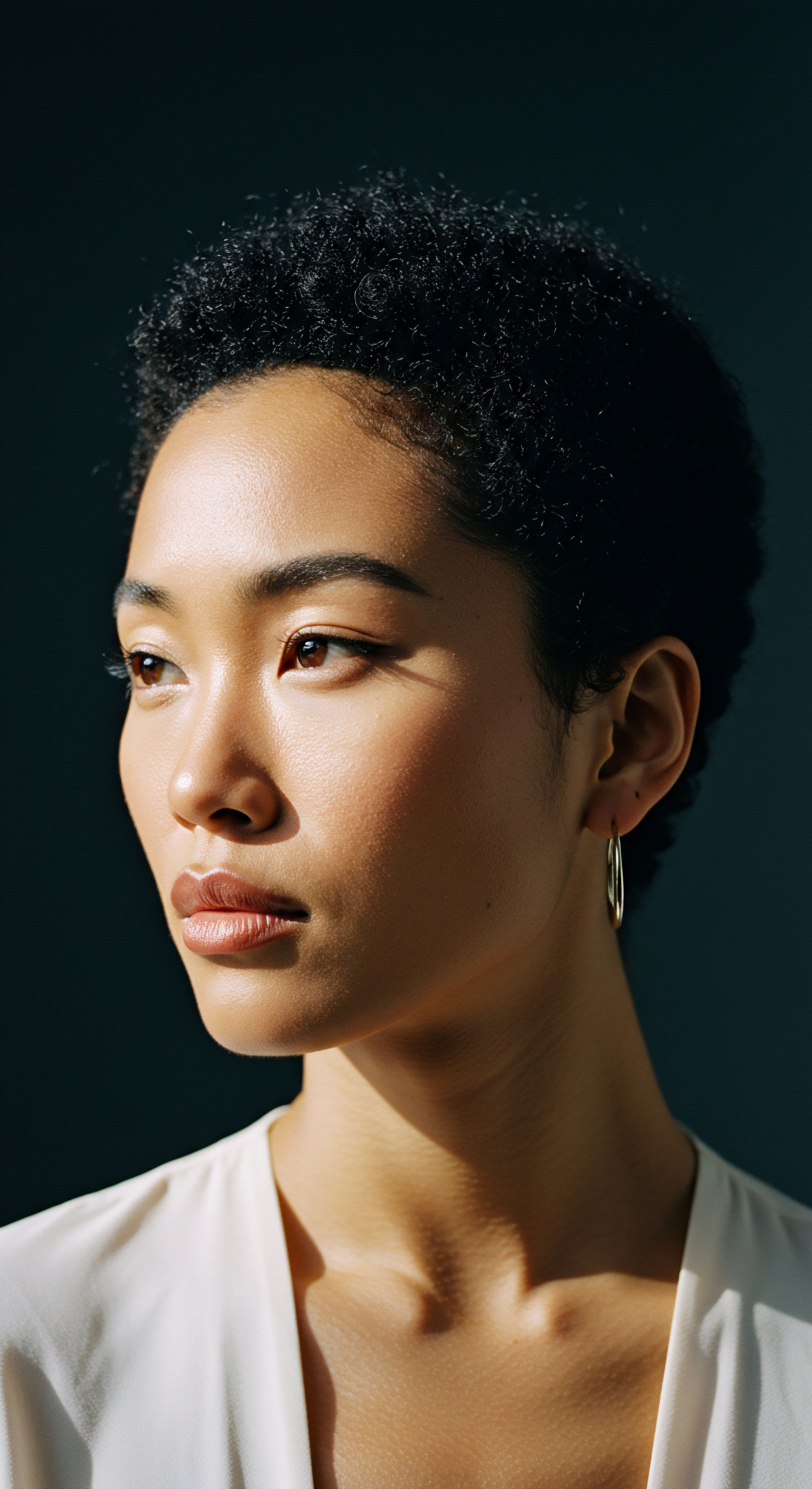
Roots
The very ground from which our textured strands rise, the scalp, often goes unseen, yet it holds a universe within its delicate landscape. It is a vibrant, living garden, a miniature ecosystem humming with invisible life. This is the scalp microbiome, a dynamic community of microscopic beings—bacteria, fungi, and yeasts—coexisting and interacting, much like the varied flora and fauna of a grand forest.
For generations, textured hair communities have practiced scalp oiling, a ritual passed down through hands and wisdom, often intuitively understood as a way to nourish the hair. But beneath the surface, what conversations are these oils truly having with the unseen residents of our scalp?
Understanding the scalp’s foundational biology provides clarity for its daily care. The skin on our head, distinct from other body areas, boasts a higher density of hair follicles and sebaceous glands. These glands produce sebum, a natural oil, which forms a lipid-rich environment.
This unique setting, along with moisture levels, pH, and oxygen availability, shapes the particular microbial populations that call our scalp home. Among these residents, certain groups stand out.
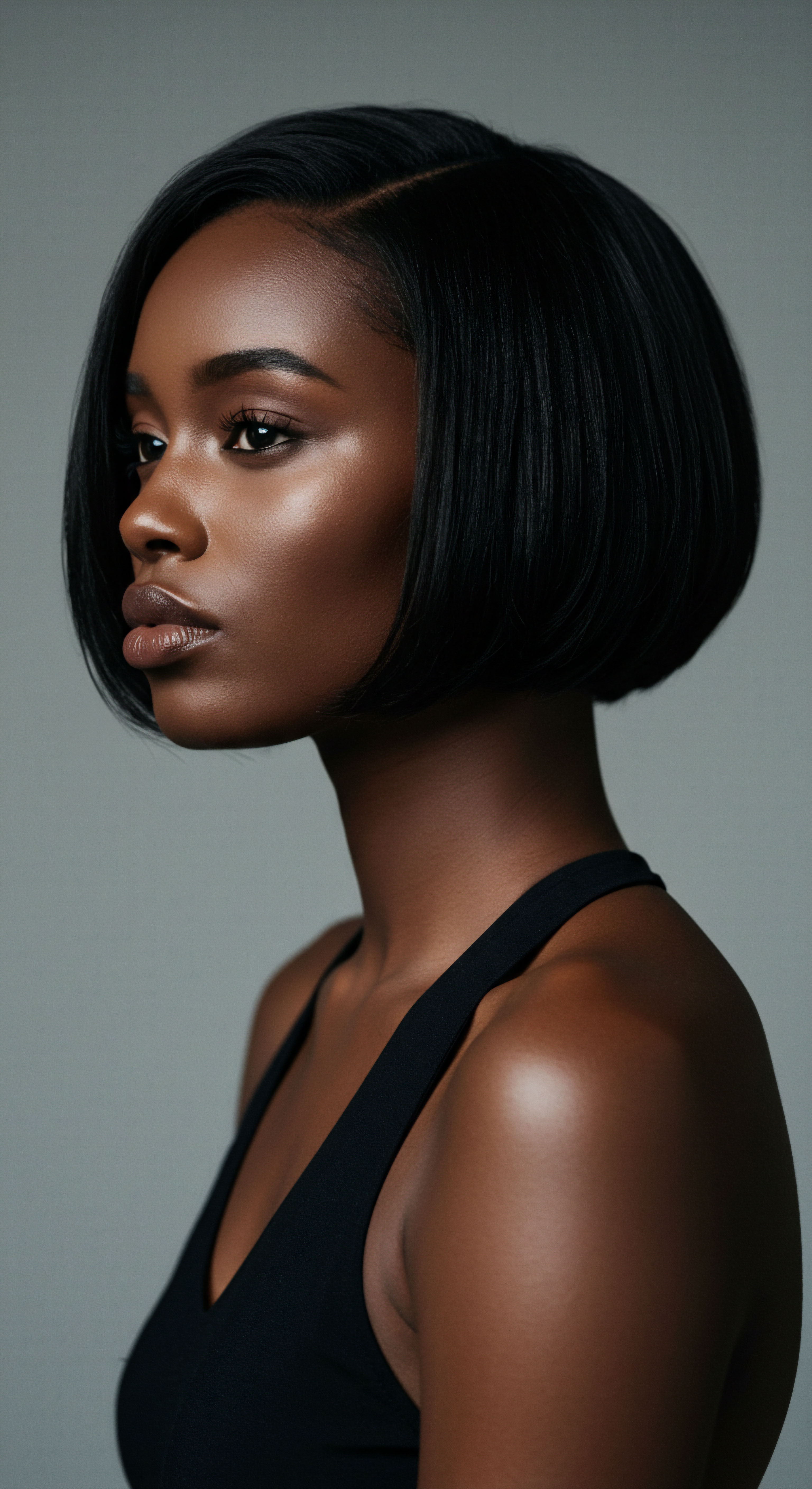
The Scalp’s Microscopic Inhabitants
The scalp microbiome is primarily populated by lipophilic microbes, those that thrive on lipids. The most abundant fungal genera include various species of Malassezia, particularly M. restricta and M. globosa, which can account for a significant portion of the fungal population.
On the bacterial side, Cutibacterium Acnes (formerly Propionibacterium acnes ) and Staphylococcus Epidermidis are frequently found. These microorganisms, in a healthy state, maintain a balanced relationship with their host, contributing to barrier function and even modulating immune responses.
- Malassezia Species ❉ These yeasts are common residents, feeding on the sebum produced by our sebaceous glands. While normally commensal, an overabundance can contribute to conditions like dandruff and seborrheic dermatitis.
- Cutibacterium Acnes ❉ This bacterium is known for its ability to metabolize lipids and is often associated with healthy scalp conditions.
- Staphylococcus Epidermidis ❉ This bacterium produces antimicrobial peptides, offering a layer of defense and influencing inflammation responses on the scalp.
The balance within this microbial community is delicate. Factors like genetics, diet, environmental exposures, and even our hair care practices can influence its composition. When this balance is disrupted, a state known as dysbiosis, it can lead to various scalp concerns, from flakiness and irritation to changes in hair quality.
The scalp is a vibrant, living garden, its unseen microbial inhabitants deeply influencing the health and appearance of our textured strands.
The intricate dance between our scalp’s natural oils and its microbial inhabitants forms the very foundation of hair wellness. Understanding this fundamental relationship allows us to approach hair care not as a series of isolated steps, but as a holistic conversation with our body’s own living systems. The journey into scalp oiling’s effects begins here, at the elemental understanding of the life thriving just beneath the surface.
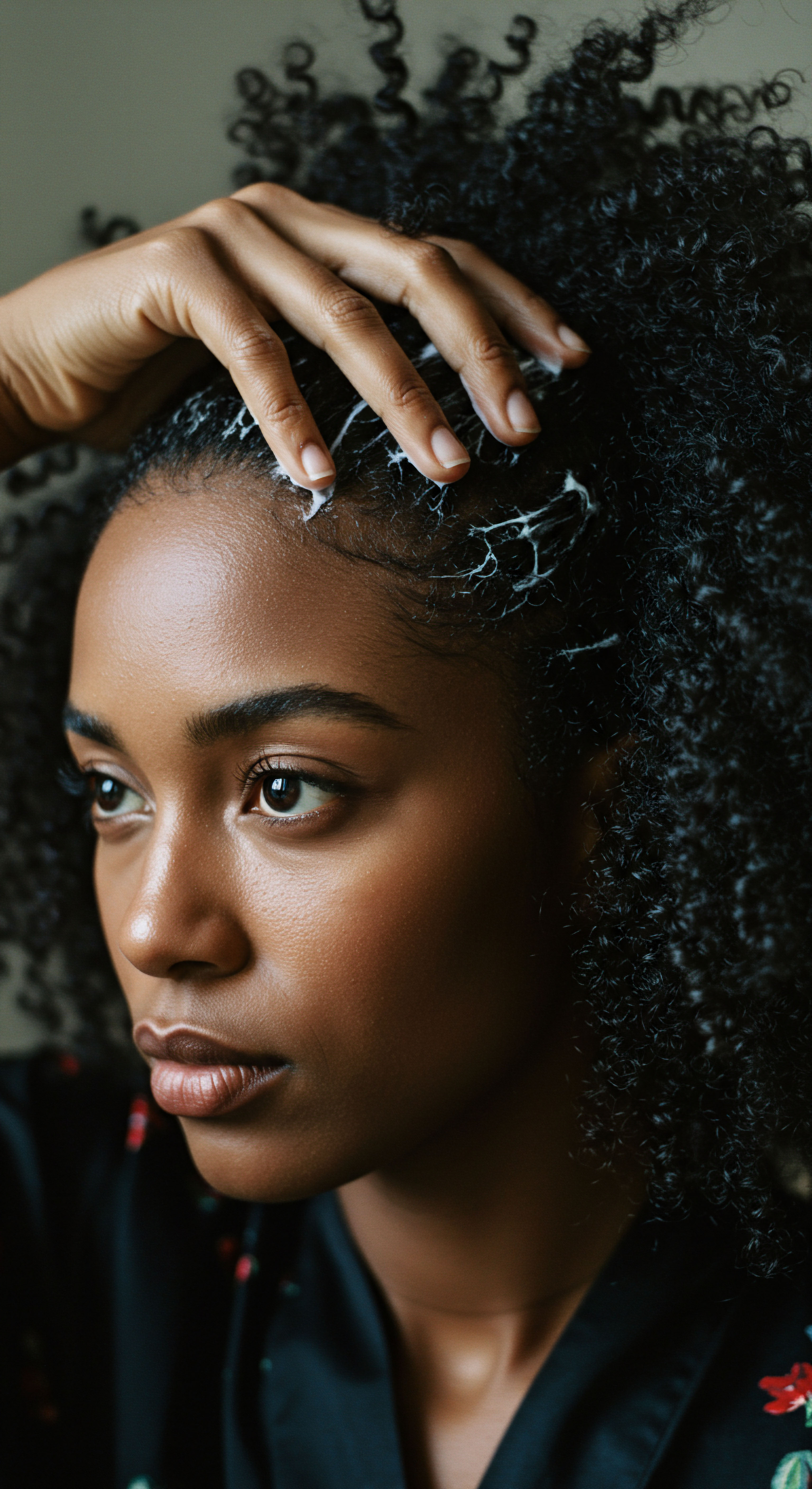
Ritual
Stepping from the foundational understanding of the scalp’s microscopic world, we turn now to the deliberate act of oiling—a practice woven into the fabric of textured hair care across cultures and generations. This is more than just applying a product; it is a ritual, a moment of connection, a gentle anointing that speaks to deep-seated traditions of care. What happens, then, when these carefully chosen lipids meet the living ecosystem of the scalp?
The intention behind this ritual is often to soften, to soothe, to bring a sense of well-being to the hair and its base. Yet, the interaction beneath the surface is a nuanced conversation between applied oils and the scalp’s microbial residents.

Traditional Applications and Modern Considerations
Across various cultures, oils have been used for their perceived ability to nourish the scalp, promote hair growth, and address concerns like dryness or flaking. From the rich, moisturizing qualities of coconut oil in South Asian traditions to the fortifying properties of castor oil in African diaspora practices, the selection of oils often reflects local botanical abundance and generations of anecdotal wisdom. Today, these practices continue, augmented by a growing scientific curiosity into their underlying mechanisms.
The very act of massaging oil into the scalp can stimulate blood circulation, which, while not directly altering microbial balance, can support overall scalp health. The oils themselves, however, introduce new lipid sources to the scalp’s surface. These lipids can be either beneficial or detrimental, depending on their chemical composition and the existing microbial profile.
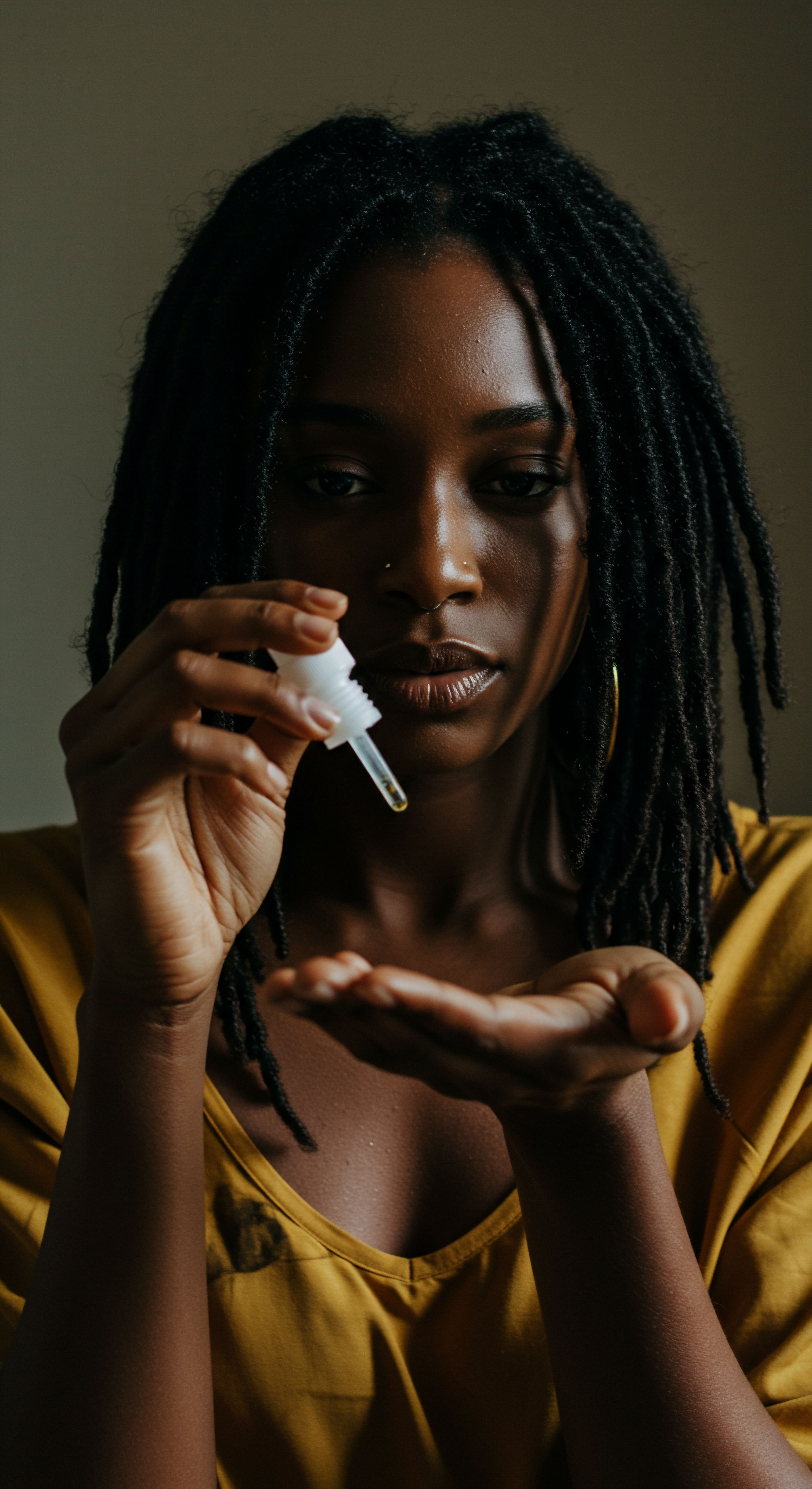
How do Different Oils Interact with Scalp Microbes?
Not all oils are created equal when it comes to their interaction with the scalp’s unseen inhabitants. The fatty acid composition of an oil plays a significant role. For instance, coconut oil, rich in lauric acid, has shown some antibacterial activity against certain bacteria, including Propionibacterium acnes and Staphylococcus aureus.
This suggests a potential to modify bacterial populations on the scalp. Castor oil, with its ricinoleic acid, possesses germicidal and fungicidal qualities.
Conversely, some oils, particularly those high in certain long-chain triglycerides (fatty acids with carbon chain lengths of 11-24), can serve as a readily available food source for lipophilic yeasts like Malassezia. An overabundance of these specific lipids, if not properly managed, could potentially contribute to an increase in these yeasts, which are implicated in dandruff and seborrheic dermatitis.
| Oil Type Coconut Oil |
| Primary Fatty Acids Lauric acid (medium-chain) |
| Microbial Interaction Potential Antibacterial properties; may reduce M. restricta while increasing M. globosa in some cases. |
| Oil Type Castor Oil |
| Primary Fatty Acids Ricinoleic acid |
| Microbial Interaction Potential Germicidal and fungicidal properties; may help protect against certain infections. |
| Oil Type Jojoba Oil |
| Primary Fatty Acids Wax esters (mimics sebum) |
| Microbial Interaction Potential Non-comedogenic; less likely to feed Malassezia due to unique structure. |
| Oil Type Tea Tree Oil (diluted) |
| Primary Fatty Acids Terpinen-4-ol |
| Microbial Interaction Potential Anti-inflammatory, antibacterial, and antimicrobial properties. |
| Oil Type Olive Oil |
| Primary Fatty Acids Oleic acid (long-chain) |
| Microbial Interaction Potential Can serve as a food source for Malassezia if not properly cleansed. |
| Oil Type Understanding the lipid profiles of oils helps predict their effect on the scalp's microbial landscape. |
The application frequency and thoroughness of cleansing also play a significant role. Leaving heavy oils on the scalp for extended periods without adequate removal can create an anaerobic (low oxygen) environment, potentially favoring the growth of certain bacteria or fungi. A balanced routine, which includes careful application and gentle, effective cleansing, is essential to support a harmonious scalp environment.
Oiling is a ritual of care, yet its interaction with the scalp’s unseen life depends on the oil’s chemistry and how it is applied.
The choice of oil and the mindfulness with which it is used become integral parts of the scalp’s overall wellness. It is a dance between tradition and contemporary understanding, where each stroke of oil can influence the delicate, unseen world thriving at the very roots of our hair.

Relay
Moving beyond the gentle touch of ritual, we now approach the deeper currents where science and tradition converge, exploring the intricate dialogue between scalp oiling and its microbial inhabitants. This is where the unseen forces of biology, the subtle shifts in microscopic populations, come into sharper focus. How does the deliberate act of oiling truly alter the delicate equilibrium of the scalp microbiome, and what does the latest research tell us about these complex interactions?
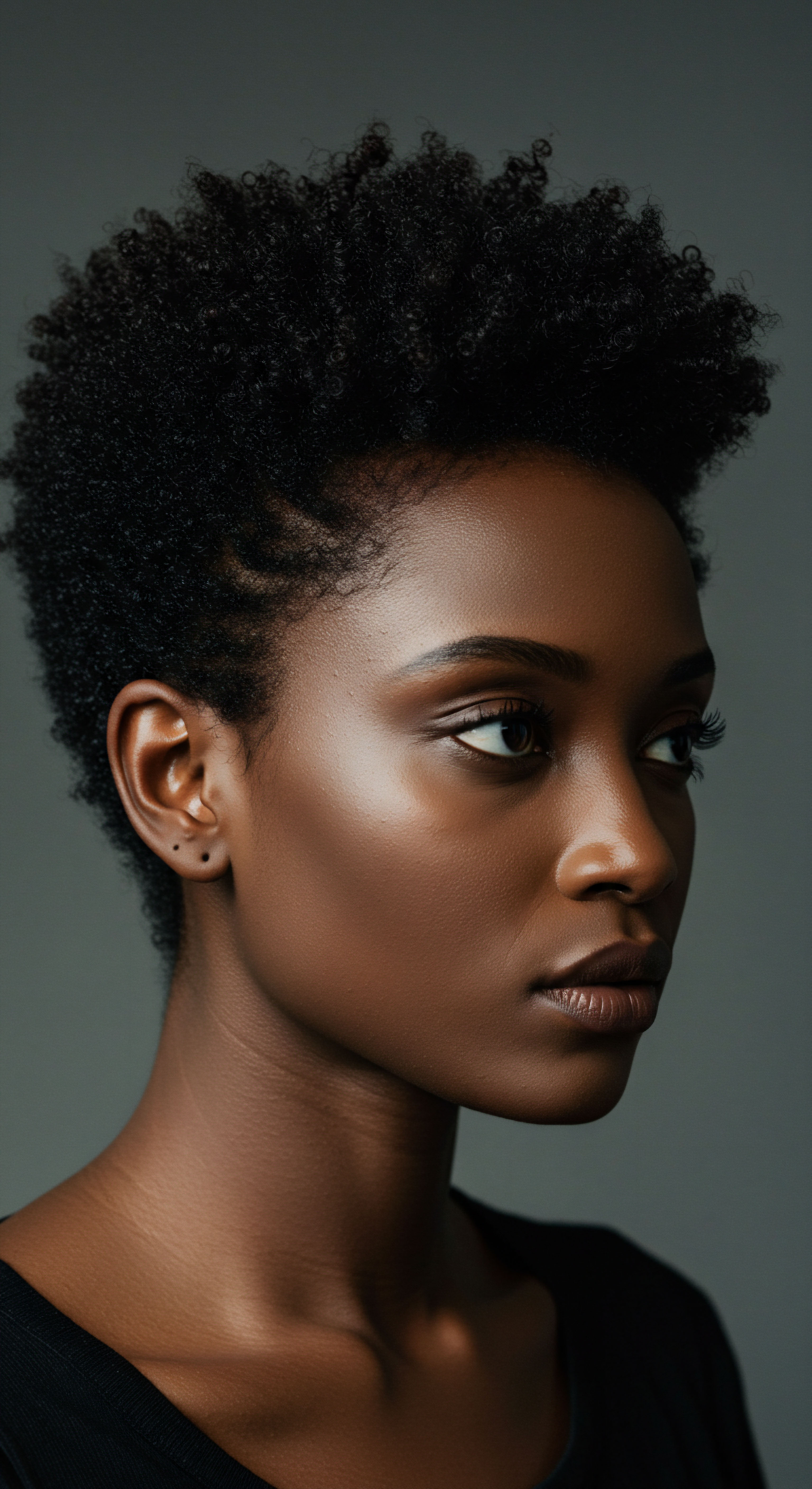
The Scientific Lens on Microbial Shifts
The scalp microbiome, as a living entity, constantly adapts to its surroundings, including the presence of topically applied substances like oils. When oils are introduced, they serve as substrates, influencing the metabolic activities and population dynamics of the resident bacteria and fungi. The composition of the oil, its viscosity, and the frequency of application all contribute to a cascading effect on this microscopic world.
Research has begun to illuminate specific instances of this interaction. For example, a longitudinal study involving 140 Indian women, both with and without dandruff, investigated the effects of topical coconut oil application on the scalp microbiome. The findings revealed that coconut oil application could enrich healthy scalp commensals. Specifically, the study observed an increase in the abundance of Cutibacterium Acnes and Malassezia Globosa in dandruff-affected scalps after treatment, and these increases were negatively correlated with dandruff parameters.
The study also noted a significant reduction in M. restricta in dandruff scalps. This suggests that rather than simply feeding problematic microbes, coconut oil, in this context, appeared to support a more balanced microbial community.
Scientific inquiry reveals how specific oils can subtly reshape the scalp’s microbial landscape, often for the better.
The implications here are profound. It suggests that certain oils possess more than just moisturizing properties; they can act as selective agents, promoting the growth of beneficial species or inhibiting those associated with dysbiosis. The outcome is not merely about suppressing unwanted guests, but about fostering a harmonious environment where the natural defenders of the scalp can thrive.

Do Oils Feed Malassezia and Cause Dandruff?
This question surfaces frequently, and the answer is not a simple yes or no. Malassezia yeasts are indeed lipophilic, meaning they require lipids for growth. They produce enzymes called lipases to break down sebum triglycerides into fatty acids, which they then consume.
However, the type of fatty acid matters significantly. While Malassezia thrives on certain long-chain fatty acids (like oleic acid, which is present in some oils and is a byproduct of sebum breakdown), it does not readily consume medium-chain triglycerides (MCTs) or squalane.
A critical finding from research points to the role of Squalene Peroxidation. Squalene, a major component of sebum, can be peroxidized (oxidized) on the scalp, especially in dandruff-affected areas. This peroxidized squalene ( squalene monohydroperoxide or SQOOH) is significantly more abundant in dandruff scalps and can induce inflammation and keratinocyte proliferation, contributing to flaking. Intriguingly, Malassezia species have been shown to contribute to this squalene peroxidation.
This suggests that the issue is not merely the presence of oil, but the metabolic byproducts of Malassezia acting on certain lipids, leading to inflammatory responses. Therefore, selecting oils with fatty acid profiles less prone to Malassezia -induced peroxidation or those with antimicrobial properties can be beneficial.
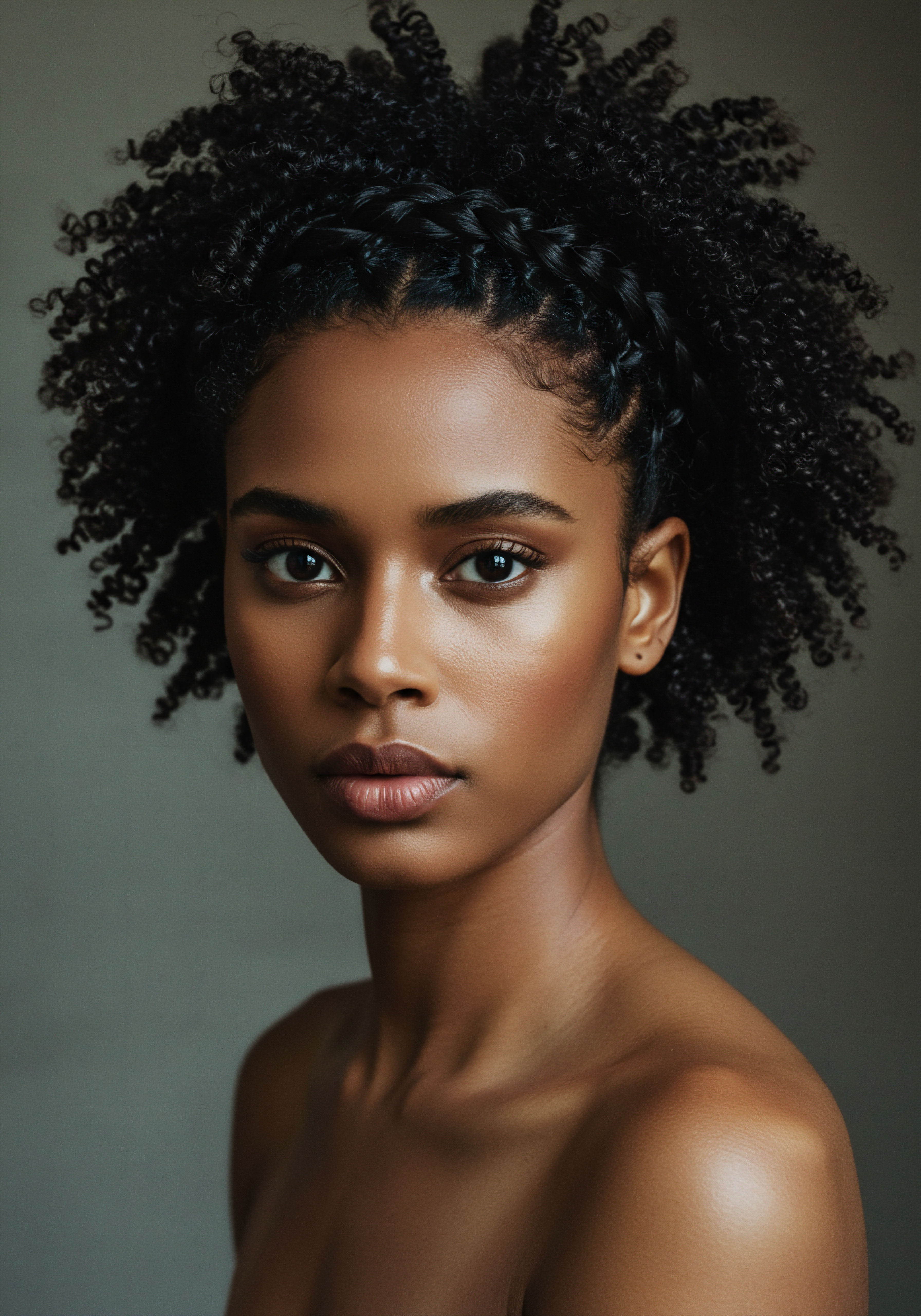
Can Oiling Alter Bacterial Diversity on the Scalp?
The bacterial populations on the scalp also respond to oiling. Healthy scalps are typically dominated by Cutibacterium acnes and Staphylococcus epidermidis. A study found that in healthy individuals, coconut oil increased bacterial diversity. This suggests that for a well-functioning scalp, oiling can contribute to a richer, more resilient bacterial community.
Conversely, an imbalanced scalp microbiome, characterized by reduced bacterial diversity and an overabundance of certain species, is associated with conditions like sensitive scalp.
- Oils as Metabolic Substrates ❉ Applied oils introduce diverse fatty acids and other compounds that serve as food sources for various microbes. The specific fatty acid chain length and saturation influence which microbial species can metabolize them.
- Impact on PH and Moisture ❉ Oiling can influence the scalp’s pH and moisture levels, indirectly shaping the microbial environment. A healthy scalp typically maintains a slightly acidic pH, which can deter the growth of certain pathogens.
- Antimicrobial Properties ❉ Many natural oils, such as tea tree, rosemary, and lavender, possess inherent antimicrobial or anti-inflammatory properties, directly impacting problematic microbial populations or reducing scalp irritation.
The interplay is dynamic and depends on numerous variables, including the individual’s inherent scalp physiology, the specific oil used, the application method, and the frequency of cleansing. A single, blanket statement about oiling’s effect on the microbiome falls short of the true complexity. Instead, it is a continuous interplay, a conversation where our choices influence the unseen world at our roots.
The historical practice of oiling, when viewed through this scientific lens, gains a deeper scientific grounding. It is a subtle art of maintaining balance, supporting the beneficial, and gently guiding the opportunistic, ensuring that the living landscape of the scalp remains a welcoming home for vibrant, healthy hair.

Reflection
As we step back from the intricate world of the scalp microbiome and its delicate dance with oils, a quiet truth settles. The wisdom passed down through generations, the intuitive touch of oiling textured hair, carries echoes of scientific insight we are only now beginning to articulate. It is a reminder that the most profound acts of care often reside in the unseen, in the subtle shifts of balance that allow life to flourish. Our journey into the scalp’s hidden ecosystem reveals that healthy hair begins not just with external adornment, but with a deep reverence for the biological symphony playing out at its very base.
Each gentle application, each thoughtful choice of oil, contributes to this harmony, a testament to the enduring connection between our practices, our heritage, and the living vitality of our hair. The conversation between tradition and discovery continues, inviting us to listen closely to the whispers of our own unique scalp story.

References
- Townsend, N. Hazan, A. & Dell’Acqua, G. (2023). New Topicals to Support a Healthy Scalp While Preserving the Microbiome ❉ A Report of Clinical and in Vitro Studies. Journal of Clinical and Aesthetic Dermatology, 16 (10 Suppl 1), S4–S11.
- Mysore, V. & Arghya, A. (2022). Hair Oils ❉ Indigenous Knowledge Revisited. International Journal of Trichology, 14 (3), 84–90.
- Jourdain, R. (2016). Exploration of scalp surface lipids reveals squalene peroxide as a potential actor in dandruff condition. Archives of Dermatological Research, 307 (3), 153-163.
- Reinking, A. R. & Sivamani, R. K. (2022). The Gut and Skin Microbiome in Alopecia ❉ Associations and Interventions. Journal of Clinical and Aesthetic Dermatology, 15 (7), 38–43.
- Ghorbanpour, M. & Hadian, M. (2020). Essential Oils for Hair Health and Growth. Healthline .
- Vinmec. (2024). Essential Oils for Hair Growth. Vinmec International Hospital .
- Examine.com. (2021). Coconut oil for dandruff ❉ Effects on the scalp microbiome – Study Summary. Examine.com .
- NaturallyCurly. (2015). What You Need to Know About Antibacterial, Antioxidants, Antifungal, and Anti-inflammatory Oils. NaturallyCurly .
- L’Oréal Research and Innovation. (2016). Squalene peroxide is a potential actor in dandruff condition. L’Oréal Research and Innovation .
- Jourdain, R. et al. (2016). Exploration of scalp surface lipids reveals squalene peroxide as a potential actor in dandruff condition. Springer Medizin .
- Siesta Head Spa. (2024). Discover the Benefits of Essential Oils for Scalp and Hair Health. Siesta Head Spa .
- Vibiosphen. (n.d.). Malassezia restricta involvment in dandruff pathology. Vibiosphen .
- OCHRE. (2024). Malassezia ❉ The Yeast of Your Problems. OCHRE .
- Good Biome. (n.d.). Good Biome Seborrheic Scalp Solution and Prebiotic Scalp Oil Bundle. Good Biome .
- Bayliss, S. J. et al. (2020). Influence of hair oil on scalp fungal cultures. Pediatric Dermatology, 37 (5), 977-978.
- Bayliss, S. J. et al. (2020). Influence of hair oil on scalp fungal cultures. ResearchGate .
- Wijaya, A. et al. (2020). Extracellular Lipase of Malassezia as Anti Dandruff Drug Target. Systematic Reviews in Pharmacy, 11 (8), 447-452.
- Krader, C. G. (2020). Myth debunked ❉ Hair oil and fungal cultures. The Dermatology Digest .
- A. N. & Anand, A. (2010). Antifungal properties of neem (Azadirachta indica) leaves extract to treat hair dandruff. E-ISRJ, 2, 244-252.
- Tao, R. Li, R. & Wang, R. (2020). Skin microbiome alterations in seborrheic dermatitis and dandruff ❉ A systematic review. Journal of Cosmetic Dermatology .
- Saxena, R. et al. (2021). Longitudinal study of the scalp microbiome suggests coconut oil to enrich healthy scalp commensals. Scientific Reports, 11 (1), 7220.
- MDPI. (n.d.). Scalp Microbiome and Dandruff—Exploring Novel Biobased Esters. MDPI .
- The Secret Life of Skin. (2022). What is the scalp microbiome and why is it important for our health? The Secret Life of Skin .
- James, P. (2023). A Guide to Scalp Microbiome. Penny James Trichology .
- Verywell Health. (2024). Should You Use Coconut Oil for Dandruff? Verywell Health .
- DeAngelis, Y. M. et al. (2007). A model of the role of Malassezia lipase-mediated hydrolysis of scalp lipids in the etiology of dandruff and seborrheic dermatitis. ResearchGate .
- Kaushik, V. Chogale, R. & Mhaskar, S. (n.d.). Enhancing Hair Health. Effects of Oiling, Inside & Out, Part I. ResearchGate .
- Clavaud, C. et al. (2023). Selenium disulfide ❉ a key ingredient to rebalance the scalp microbiome and sebum quality in the management of dandruff. European Journal of Dermatology, 33 (S1), 5-12.
- Kim, S. et al. (2023). Psychobiotics-like Activity as a Novel Treatment against Dry Scalp Related-White Flakes Production with Pogostemon cablin Leaf Extract. MDPI .
- Cho, Y. J. et al. (2021). Skin Commensal Fungus Malassezia and Its Lipases. Journal of Microbiology and Biotechnology, 31 (5), 659-668.
- Tsai, W. H. et al. (2023). Heat-killed Lacticaseibacillus paracasei GMNL-653 ameliorates human scalp health by regulating scalp microbiome. BMC Microbiology, 23 (1), 227.
- Hu, P. et al. (2024). Scalp microbiome composition changes and pathway evaluations due to effective treatment with Piroctone Olamine shampoo. International Journal of Cosmetic Science, 46 (3), 333-347.
- The Secret Life of Skin. (2023). Scalp microbiome ❉ Where research needs to go next. The Secret Life of Skin .
- NYSCC. (2023). Restore hair and scalp equilibrium for holistic beauty! NYSCC .
- Healthnews. (2025). Scalp Microbiome Explained ❉ What’s Living on Your Scalp and Why It Matters. Healthnews .
- Saxena, R. et al. (2021). Longitudinal study of the scalp microbiome suggests coconut oil to enrich healthy scalp commensals. PubMed .
- The Secret Life of Skin. (2023). The Secret World Under Your Hair ❉ How The Scalp Microbiome Keeps Your Scalp Healthy. The Secret Life of Skin .
- Mohd Zin, S. N. et al. (2017). A Study on Scalp Hair Health and Hair Care Practices among Malaysian Medical Students. International Journal of Trichology, 9 (2), 58–62.
- SciSpace. (2023). Top 53 International Journal of Trichology papers published in 2023. SciSpace .
- BiomeCentric. (2024). The scalp microbiome ❉ The key to next-gen hair care. BiomeCentric .
- Patil, A. (2022). Essential Oils for Hair Health ❉ A Critical Mini-Review of the Current Evidence and Future Directions. ResearchGate .
- Ablon, G. (2024). Scalp microbiome ❉ a guide to better understanding scalp diseases and treatments. PubMed .
- Townsend, N. Hazan, A. & Dell’Acqua, G. (2023). New Topicals to Support a Healthy Scalp While Preserving the Microbiome ❉ A Report of Clinical and in Vitro Studies. ResearchGate .